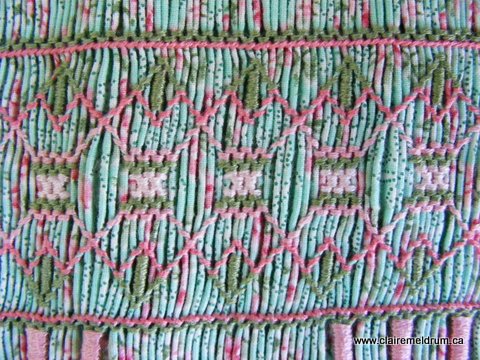I’m always a little suspicious of pristine cookbooks. Sure, if it’s brand new and I’m browsing at the bookstore, pretty pictures and pristine, crisp pages are wonderful. But if someone recommends a cookbook and their copy is immaculate, without a smudge of flour, or a smear of batter, I start to wonder just how good the food really is. At my house, the cookbooks I use regularly look like they’ve served in the trenches, but that’s OK because it means they’re being put to the use they were intended for.

Should I apply the same logic to smocking books? If so, my copy of Grace Knott’s classic, “English Smocking,” comes with decades of recommendation behind it, too. Before it was mine, this was my mom’s copy, printed in the late seventies; my sister and I wore dresses smocked with designs from this book when I was a little girl in the mid-eighties. And my great aunt Lois (who was Martha Stewart before Miss Stewart was even a glimmer in her parents’ eye), smocked for her step-daughter in the 1940s using an earlier edition. Grace Knott really established smocking and kept it alive before its revival. This book is well-loved, to put it mildly.

I think there’s a tendency amongst smockers (and I’m certainly guilty of this!) of preferring the shiny glossy designs of recent publications. The colours and fabrics are up to date and it’s so easy to envision the finished product, thanks to the step by step photographs. Old designs seem kind of daunting, with their spare, written directions and dated colour schemes. Yellows and browns? Ewww. Orange and green? Yuck. How could anyone smock anything so old-fashioned?

So, do you think my lastest smocking project looks out of date? Because I sure don’t and yet, it’s a design that was published almost four decades ago.

All I’ve done is change the colour palette and switch out the wrapped roses and stacked cable baskets for bullions and open herringbone. And suddenly, the symmetry and classic proportions look timeless and fresh once again.

There’s a lot of wonderful detail in this plate – colours and stitches are built on top of each other to give a wonderful sense of depth and complexity. This was certainly a very involved design but totally worth it, I think.

The baskets are one of my favourite details: Big, three colour roses, surrounded by smaller bullion buds, detached chain and a smattering of pink french knots, all sitting in a herringbone stitch basket. The basket, if I do say so myself, was a stroke of genius. Not only is the texture a dead ringer for actual wicker but it serves a secret purpose as well.

That’s because herringbone is one of the must-stitches for smockers submitting their garments and samplers for Level 2 Artisan evaluation. When you add in the fact that bars and spools are also required stitches, this plate was a perfect fit. And since most contemporary designs shy away from spools and bars – trellis and wave stitch definitely predominate – finding a plate that I could use on my partial yoke dress example made choosing a vintage design like this a no-brainer.

Of course, I still have to construct the dress but that will have to wait until I finish my term papers (on Dorothy Wordsworth and Lucy Hutchinson, in case any of you have any interest in either Romantic poetry or early modern translation). So there you have it, a classic design updated but still true to its smocking roots!















 If I was completing an heirloom quality quilt, I’d probably still go with marking the backs of squares 7/8″ larger than the finished size but for this type of casual quilt, the rulers both worked very well.
If I was completing an heirloom quality quilt, I’d probably still go with marking the backs of squares 7/8″ larger than the finished size but for this type of casual quilt, the rulers both worked very well.







